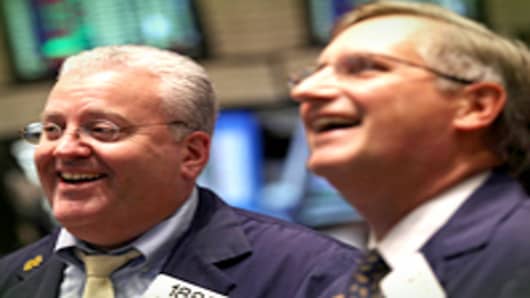Coming off the market's worst monthly performance in three years, there are scattered signs that while the damage is not over yet, the worst may have passed—at least for the moment.
At times like these, investors will take anything positive they can get.
So indicators, such as the stock market's trend to bounce back after awful third-quarter performances, and a chart diagram showing that stocks are near the completion of a bearish trend, are welcome news for the weary.
"Very few investors will be unhappy to see September—or the third quarter, for that matter—slip rapidly into distant memory," Sam Stovall, chief equity strategist at Standard & Poor's, said in a note to client that reasonably can be considered an understatement.
Stovall presents what is possibly the most compelling data point for stock market bulls, namely that when the third quarter sees an official correction , or a 10 percent or more drop, the ensuing quarter is almost always positive.
The S&P 500 for the July-to-September period lost 12 percent heading into Friday's trading, which saw the market add to its losses. History, then, suggests that the following quarter will post a gain of 7.2 percent. The trend has held up eight out of nine times.
So while that's good news in the near term, investors better enjoy it while it lasts, as economic headwinds from within and without—namely, the continuing debt saga in southern Europe—still loom large.
"Don’t begin to think that green arrows will signal a change of long-term market direction, as we still believe equities will again trend lower after the traditional year-end rally," Stovall said. "The best of the quarterly returns are likely behind us. While history shows us that the market’s performance in the coming five quarters may be good, it may not be great."
Another area of support for the market, though, comes from a chart pattern diagnosed by Abigail Doolittle, head of Peak Theories Research in Albany, N.Y.
Doolittle explores various geometric patterns that may not be familiar to the average investor but have served her well, particularly this year when she predicted, back in February, that commodities were headed for collapse.
In her latest research, she finds a "bearish Band-Aid rip" that suggests a near-term bottoming for the market, but then a rally afterwards.
"Such a potential new lows carve-out will come quickly enough—perhaps today into next week—that it may feel like the beginning of a real collapse as it takes markets into bear market territory," she wrote in a note Friday. "However, if those potential new lows at about 5 percent below this year’s current lows end up finding support as the charts also suggest, the possible new lows carve-out will feel like a Band Aid being ripped off...once it’s over, it may actually be over."
Doolittle said a continued rise of the dollar against the eurowill put pressure on U.S. stocks, possibly dropping the S&P 500 index to 1075, but that "may be the real driver of a possible bearish Band-Aid rip, or the final phase of the cruel correction."
Technical indicators, though, have been of decreasing value, particularly when it comes to Dow Theory and the half-dozen indicators it uses to determine market movements.
Instead, the markets lately have been driven by headlines, in particular whether policymakers have their arms around the euro zone debt crisis , if an intensifying of that will send the U.S. into recession, or whether the U.S., independent of European pressures, will still enter recession.
Jim Paulsen, chief market strategist at Wells Capital Management in Minneapolis, sees a fourth-quarter rally fueled by the U.S. economy decoupling from Europe and clearing the recession-risk hurdle.
"That is what's going to wag the dog," Paulsen said. "Europe is what causes volatility between 1120 and 1220 (on the S&P 500). But Europe isn't what's going to take us below 1120 or above 1220. It's going to be data here in the United States."
"Next week is all about fundamental data," he added. "Right after that you hit the corporate earnings season. That's a healthier environment to be in than to be left to your worst nightmare."
Sentiment, at least, is showing some signs of improvement.
While still low, the latest survey from the American Association of Individual Investors saw the biggest increase in bullish opinions since mid-June—from 25.3 percent to 32.5 percent. At 46.8 percent the bears are still in command, but the gap is getting narrower.
The survey is representative of mixed market feelings—hopes for a year-end rally pressured against the reality of a weak U.S. and global economy.
"If you keep getting this sort of nonrecessionary data it's hard to imagine that it keeps getting ignored," said Dan Greenhaus, chief global strategist at BTIG in New York. "I'm staying somewhat optimistic that we could get to 1250 or 1300 on the (S&P 500), to the bottom of the previously existing range. Then maybe somewhere next year we have some type of rollover. But clearly the bias is to the downside. There's just no buying power."



